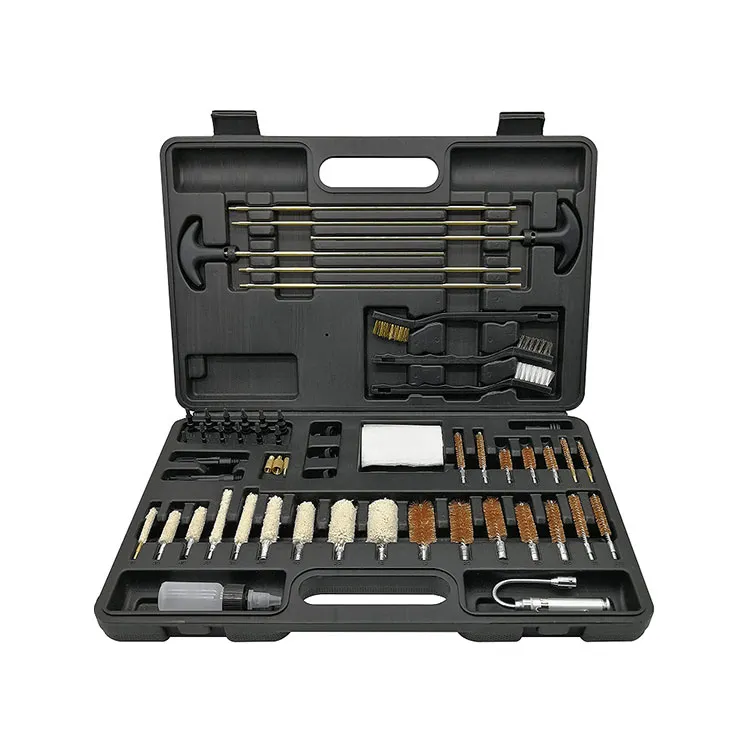The Importance of a Gun Cleaning Kit: Keeping Your Firearm in Top Condition
2024-10-23
Owning a firearm comes with responsibilities, not only for safety and proper usage but also for regular maintenance. One of the most essential tools for gun owners is a gun cleaning kit, which ensures that firearms remain in top working condition, preventing malfunctions and maintaining performance.
In this blog, we'll explore the components of a typical gun cleaning kit, why it's crucial to clean firearms regularly, and how to properly use a cleaning kit to extend the life of your firearm.

Why is Gun Cleaning Important?
Firearms are precision-engineered tools that need regular care to function correctly. Each time a gun is fired, residues from gunpowder, lead, copper, and carbon build up in the barrel and other parts of the firearm. These residues, if not cleaned, can lead to several issues:
1. Decreased Accuracy: Debris inside the barrel can affect the bullet’s trajectory, reducing the firearm’s accuracy over time.
2. Corrosion and Rust: Moisture and residue can lead to rusting, especially in humid conditions, which can damage metal parts and affect the firearm’s reliability.
3. Malfunctions: Dirty guns are more prone to jamming and misfiring. Regular cleaning ensures that the firearm cycles smoothly and operates as intended.
4. Longevity: Proper maintenance extends the life of the firearm by preventing wear and tear caused by dirt and debris.
In short, cleaning a firearm is an essential part of responsible gun ownership, ensuring that the weapon is safe, reliable, and ready for use.
What’s Inside a Gun Cleaning Kit?
A gun cleaning kit typically includes several tools and supplies, each designed to clean specific parts of the firearm. While the contents may vary depending on the type of firearm (rifle, shotgun, handgun, etc.), most kits contain the following essential components:
1. Cleaning Rod
A cleaning rod is used to push cleaning patches or brushes through the barrel. Made from durable materials like aluminum or brass, the rod ensures that you can scrub and clean the inside of the barrel without scratching or damaging it. Some rods are sectional, meaning they can be extended or shortened as needed.
2. Bore Brushes
Bore brushes come in different sizes to match the caliber of the firearm’s barrel. They are typically made from brass or nylon bristles and are used to scrub away stubborn fouling inside the barrel. The brush is attached to the cleaning rod and passed through the barrel multiple times to remove deposits.
3. Cleaning Patches
Cleaning patches are soft, absorbent pieces of cloth that are used to apply solvents and oil to the barrel. After applying solvent with a patch, additional patches are used to wipe away debris and residue. These patches come in various sizes to fit different calibers.
4. Solvents and Degreasers
Solvents are chemical solutions used to break down and dissolve carbon, lead, copper, and powder residues inside the barrel and other parts of the firearm. A good solvent ensures that even the most stubborn deposits are loosened, making the cleaning process more effective.
5. Gun Oil or Lubricant
After cleaning, the firearm needs to be lubricated to ensure smooth operation. Gun oil prevents friction between moving parts, reduces wear, and protects the metal surfaces from rust and corrosion. A light coat of oil is typically applied to the barrel, slide, and other metal components.
6. Patch Holder or Jag
The patch holder or jag is a small attachment that fits onto the cleaning rod to hold the cleaning patches. It ensures that the patch is snug inside the barrel, allowing it to thoroughly wipe the interior surfaces as you move it back and forth.
7. Cotton Swabs and Brushes
For smaller and hard-to-reach areas, like the action, trigger, and magazine well, cotton swabs and brushes are essential. These tools help clean tight corners and intricate parts where debris can accumulate over time.
8. Bore Snake
A bore snake is a flexible, one-piece cleaning tool that can be pulled through the barrel to quickly clean it. It is embedded with brushes and woven fibers that scrub and wipe the barrel in a single pass. Bore snakes are often used for quick cleanings between more thorough maintenance sessions.
How to Clean a Firearm Using a Gun Cleaning Kit
Properly cleaning a firearm involves several steps, ensuring that all parts are cleaned, lubricated, and inspected for wear or damage. Here’s a step-by-step guide on how to use your gun cleaning kit:
Step 1: Safety First
Before beginning any cleaning, ensure the firearm is unloaded. Remove the magazine and check the chamber to ensure no ammunition is present.
Step 2: Disassemble the Firearm
Refer to the manufacturer’s instructions for disassembling your firearm. For most guns, this means removing the barrel, slide, and other components that need cleaning. Avoid taking apart more than necessary unless you're familiar with the firearm’s mechanics.
Step 3: Apply Solvent
Attach the bore brush to the cleaning rod and dip it in solvent. Run the brush through the barrel several times to loosen carbon and lead deposits. After scrubbing, let the solvent sit for a few minutes to break down stubborn fouling.
Step 4: Use Cleaning Patches
Switch to the patch holder and attach a clean patch to the rod. Run the patch through the barrel to remove the dissolved fouling and excess solvent. Repeat this process with new patches until they come out clean.
Step 5: Clean Other Components
Use the brushes and cotton swabs to clean the slide, action, chamber, and other parts of the firearm. Apply solvent to these areas if necessary, and wipe away the residue with clean patches or cloths.
Step 6: Inspect and Lubricate
After cleaning, inspect the firearm for any signs of wear or damage. Apply a light coat of gun oil to the moving parts, including the barrel, slide, and other metal surfaces, to ensure smooth operation and protect against corrosion.
Step 7: Reassemble and Wipe Down
Once everything is clean and lubricated, reassemble the firearm according to the manufacturer’s instructions. Finally, use a soft cloth to wipe down the exterior of the firearm, removing fingerprints and excess oil.
Choosing the Right Gun Cleaning Kit
When selecting a gun cleaning kit, consider the following factors:
- Caliber Compatibility: Make sure the kit is suitable for the type of firearm you own. Kits are often designed for specific calibers, so choose one that matches your gun.
- Quality of Tools: Look for high-quality materials like brass cleaning rods and sturdy bore brushes that will not damage the firearm during cleaning.
- Portability: For shooters who travel to ranges or outdoor locations, a compact, portable cleaning kit is convenient to carry and use on-site.
- Comprehensive Kits: A good cleaning kit should include everything you need for a thorough cleaning, from solvents and oils to brushes and patches.
Conclusion
A well-maintained firearm is not only more reliable and accurate but also safer to use. Regular cleaning with a gun cleaning kit helps prevent malfunctions, improves longevity, and keeps your gun functioning at its best. By investing in a quality cleaning kit and following a consistent maintenance routine, you’ll ensure your firearm remains in peak condition for years to come.
Whether you’re a seasoned hunter, a competitive shooter, or a gun enthusiast, maintaining your firearm with a proper cleaning regimen is essential for its long-term performance and safety.


